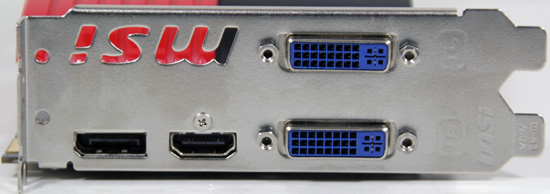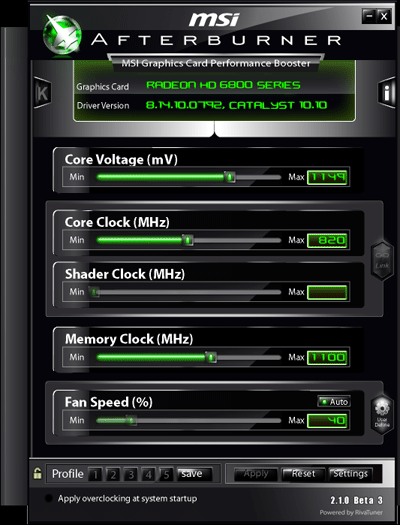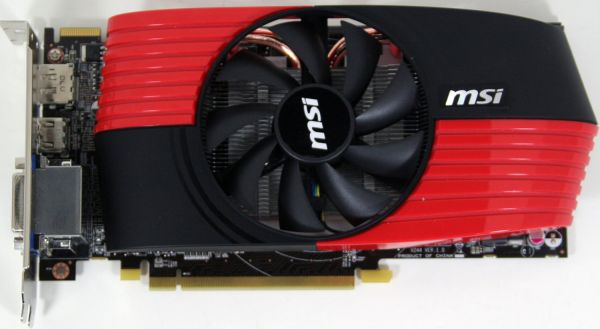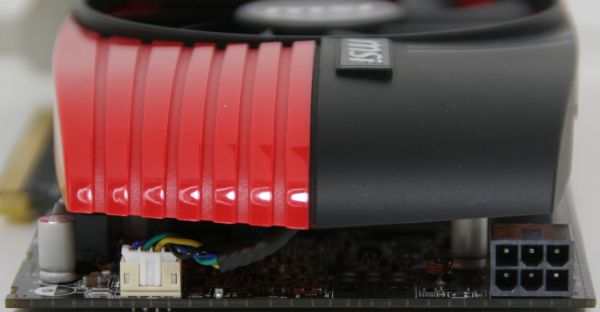AMD Radeon HD 6850 Overclocking Roundup: Asus, XFX, & MSI
by Ryan Smith on November 8, 2010 12:40 AM ESTMeet The MSI R6850 OC
The final card in today’s roundup is MSI’s R6850 OC. The R6850 OC is one of the first 6850s being released with a significant overclock, with MSI releasing it at 820MHz core and 1100MHz (4400MHz effective) memory, a 45MHz (5.8%) core and 100MHz (10%) memory overclock respectively. Besides the overclock, the card is identical to MSI’s existing R6850, using the same PCB and cooler as its stock-clocked counterpart.
Starting with the PCB, MSI is also using a non-reference PCB, this time using a shorter 8.5” PCB. In fact it's the same PCB as on the XFX card, leading us to believe that this is an alternative 1x DisplayPort PCB from AMD. In any case, because it's the same PCB as the XFX it means it's sharing the same design flaws: MSI has kept the PCIe power sockets on the rear of the card, so the practical length of the card is longer. Furthermore in the case of the MSI card, the card’s plastic shroud hangs over the end of the card, making the card 9” long in practice. As a result the end-user benefits of the shorter PCB are more or less wasted.
Attached to the PCB is MSI’s cooler, which bears a striking resemblance to Asus’s DirectCU cooler. Here MSI is using a pair of copper heatpipes to transfer heat from the baseplate to an aluminum heatsink that runs most of the length of the card. In the center is an 80mm fan providing airflow for cooling, and on top of that a shroud to direct airflow out of the front and the back of the card. Compared to the Asus DirectCU cooler, the biggest differences are that MSI is using a larger fan and copper heatpipes in place of aluminum heatpipes.
As for the port configuration, MSI is using the same configuration as both XFX and Asus: two DVI ports, one HDMI port, and one full-size DisplayPort, meaning the card can drive up to 5 monitors with a DP hub.

For the R6850, MSI’s ace in the hole is the software rather than the hardware. The R6850 comes with MSI’s fantastic Afterburner software, which comes with allows overclocking and monitoring, and on the R6850 it even allows voltage modification. While MSI makes this software available for use on non-MSI cards, we always make it a point to tip our hat in their direction as Afterburner continues to be the gold standard in overclocking software.

Rounding out the package is the usual collection of odds & ends: a quick-start manual, driver/utility CD, molex-to-PCIe power adaptor, a long CrossFire bridge, and a DVI-to-VGA dongle. Unfortunately we don’t have pricing information for the R6850 OC at this time, but we’ve already seeing the stock-clocked version at around $190, so we’d expect the R6850 OC to go for around $200, a $20 markup over the AMD MSRP for a reference card and roughly in-line with other factory overclocked cards. Meanwhile on the support side of matters, MSI is providing a 3 year warranty with the card.


















93 Comments
View All Comments
Etern205 - Monday, November 8, 2010 - link
XFX cost $10 bucks more and has the exact same spec as the reference.Where does that $10 go to? To that "XFX" cut out on the I/O plate?
All of them went and have gone with a single standard display port, rather than the 2x mini DP, thus you can only have 3 monitors rather than 6 in Eyefinity mode.
Etern205 - Monday, November 8, 2010 - link
Disregard the 2nd complaint, looks like the HD6850 do not have 2x mini DP, except for the reference card in the press shotstigersty1e - Monday, November 8, 2010 - link
I think everybody was mad about the other article because it was pinning a stock ATI card with an OC'd Nvidia card.When you bring in an article about OC'd ATI cards, I want to see the competition's OC'd cards.
totenkopf - Monday, November 8, 2010 - link
I only now checked the prices...Is this a joke? What is all the fuss about the GTX460 FTW? It's the same price as a stock 5850 or 6870 and ~same performance. If you were a rational human wouldn't you buy either of those AMD cards and just OC them to the gills like the FTW... but smoke the crap out of it? more importantly, why are people up in arms about including it in this review when it isn't even supposed to compete with the 6850? It's a bad buy any way you slice it it seems.
Quidam67 - Tuesday, November 9, 2010 - link
This drama about the GTX460, in relation to *this* article is out of hand.Frist off, the evga 460 FTW card is a Factory overclock, but this article is about the custom overclocking potential of the HD6850 cards.
So if they were going to include GTX460 cards, it is irrelevent what the stock clock is. What is relevent is, after being custom overclocked, which card comes out first?
Along those lines, most people already acknowledge that this sort of comparrison is best saved for the HD6870 cards where overclocked GTX460's are more likely to meet their match.
Although I did not agree with AT's choice to include the evga GTX460 FTW in the HD 6850/70 launch article, I fail to see how they have done anything wrong with this piece. Perhaps you just need to wait for the right article to come out -so here's a suggestion, why don't you just ask for it, without hurling insults?
Lastly, I think this forum (sadly) needs moderation. Some of the behaviour here is not of an acceptable standard, and dilutes the many quality posts that are made by people of a more rational and civil nature.
vedye - Tuesday, November 9, 2010 - link
It's called credibility crisis. I just have a different feel to the Anandtech website now.Andyburgos - Tuesday, November 9, 2010 - link
(Takes a long breath, and warns about a long post)Hello everyone, and specially to the AnandTech staff.
This is my first post, for I have created an account specially for this "overclocked cards or not?" affaire; I´m late to the party, and that´s because my opinion is maybe very different to what I have seen until now, and I wouldn´t like to upset anyone.
I´m 21 years old, I work with computer hardware since I was 14, and not even living on the other side of the world (Argentina) has changed the fact that AnandTech is and was so important for my computer life as my first Athlon XP, my first 64-bit OS install or my first dual core processor. AT and the now derailed Tom´s Hardware were, back in the early 2000s, my main source of information, and the great articles on those pages helped me understand many things about computer hardware and software. Anand is GIFTED at explaining things, and I have yet to find one of his articles being boring; and the new reviewers, a bit unpolished at first and way improved now, are doing great and they provide new points of view: they make AT a more complete site.
The fact that I live in Argentina and yet AT is my primary site for hardware information is a testament to the fact that I find them completely unbiased and absolutely professional in their reviews. In my country, while there are a couple of good publications about computer science, we are very far from this great standards.
However, and with the most absolute respect, I think you need to review some of your reviewing standards. The staff has grown, and along the new points of view have come very different article layouts, wich make them a bit "harder" to read; the video card market has changed a lot in the last five or so generations, and you need to think about what to do with factory overclocked cards, as this case; processors have also changed a lot, and even Turbo results are worth discussing (i.e., what role plays thermal throthling in Intel and AMD processors and how does that affect performance instead of providing absolute numbers). As a loyal reader, wich has read every single hardware article from 2003 to now, I feel entitled to tell you what I think is best in this case, and as a general guideline to provide standars in other reviews:
1) AVAILABILITY OF THE PRODUCT: in the GTX 460 FTW case, I think you missed that a bit. I mean, it may be available in USA, but in Argentina, while we keep up the pace in the generation of the cards, we do not in brand availability. The FTW is hard to find here, I think it must be in other "remote" locations, and a part of your readers are from there; at least in my city, you´re being read more frecuently than most national publications.
Of course this does not affect the benchmarks, but it deserves a disclaimar as much as the inclussion of the FTW.
2) PARTICULARITY (couldn´t find a better word in my dictionary) OF THE PRODUCT: the FTW was a heavily overclocked, non reference, not-so-broadly-available card; it can not be compared in any way to a reference Radeon 68x0. However, it CAN and it MUST be compared DIRECTLY with overclocked, non reference, not-so-broadly-available card as the MSI 6850. The GTX470 might be very competitive in terms of performance with the 6870, but if you say "ok, the 470 is faster, but mind you, it is a hot and power hungry card" and leave it at that you are openly aproving a very, lets be polite and say "unpolished" mArch as the GF100 is, and by oblitterating the fact that the GTX470 is basically lowering the price for making up all the mess they made in the first place you are making the same ripoff that nVidia made by renaiming the 8800GT 9800 GT and then GTS250, or AMD by calling Barts 68x0. The same goes for Intel: their naming scheme SUCKS BADLY, and you should be complaining about the fact that some i5 series are even dual core, or even worse i7s in notebooks. I´m saying this because I sincerely believe that Anand is one of the smartest thinkers in the I.T. industry, and he has to be heard.
3) REFERENCE OR NOT: I will put it as simply as I can. Comparing a GTX460 FTW with a Radeon GeForce 6850 is like comparing a 1992 Nissan 240ZX stripped of all the inner panels, seats, air conditioning, etc., and the engine tuned to the max with a 2009 370Z. Both of thouse cars have made tradeoffs (noise for speed, size for performance for example) and both run at a similar final speed, but they do so in a different way. I think it is not a fair comparison: with the FTW, you get warranty along a heavy overclock, so the above comparison is not very fair, but the idea remains: compare by price, and reference or not. For example, you say that the FTW is worth having a different name such as GTX461, 465, whatever; but by comparing it to the stock 6850 you are saying "what the hell, it works out anyway" you are doing the same thing that EVGA and nVidia did by calling it 460 FTW.
4) AT always changes for the best, you are very smart at changing for this is a constantly moving industry. Review your standards permanently, and listen to your readers but don´t get mad at it: can´t please everyone.
Sorry for the long posts, and for those that will inevitably think I am a fanboy I will tell them that my 4 last video cards were Radeon 9600SE, GeForce PCX5900, GF 7300 GT, and recently GF9600GT.
Best regards Anand & staff, and keep building the best hardware site on the net.
vshin - Friday, November 12, 2010 - link
Ryan, dunno if you're still reading these comments but I just want to thank you for a good review of the various 6850 cards. It was a tremendous help.Oxford Guy - Friday, November 12, 2010 - link
Is there a way to change the fan speed profile so it won't be so aggressive/loud?Since it's using a vapor chamber, one would assume it should be able to run with a slower fan speed.
King.Koba - Thursday, December 2, 2010 - link
Now that Sapphire's 6850 Toxic edition is out. I'd like to see it compared to these other factory over-clocked cards. Sapphire has been the biggest player in ATI/AMD cards for a long time and their Toxic series has always brought a little more to the table.This time, it has a 6870 style PCB with 2 6pin connectors. The potential of having 75 more watts available might allow it to push far past the other cards which were tested. It would be interesting to see if that potential translates in real world testing.